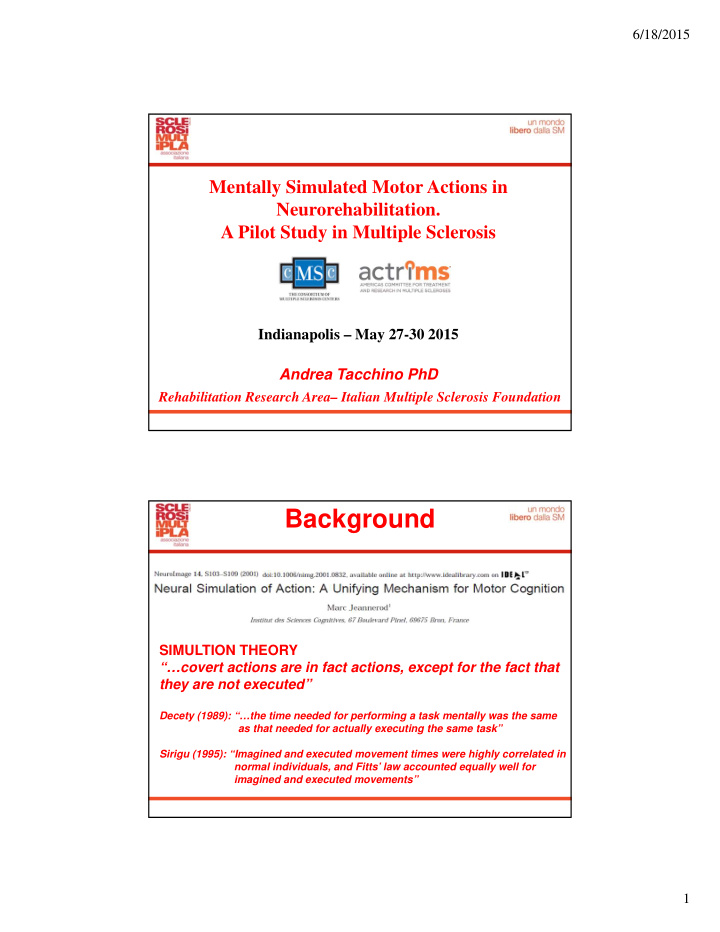



6/18/2015 Mentally Simulated Motor Actions in Neurorehabilitation. A Pilot Study in Multiple Sclerosis Indianapolis – May 27-30 2015 Andrea Tacchino PhD Rehabilitation Research Area– Italian Multiple Sclerosis Foundation Background SIMULTION THEORY “…covert actions are in fact actions, except for the fact that they are not executed” Decety (1989): “…the time needed for performing a task mentally was the same as that needed for actually executing the same task” Sirigu (1995): “Imagined and executed movement times were highly correlated in normal individuals, and Fitts’ law accounted equally well for imagined and executed movements” 1
6/18/2015 Background To investigate whether and which role Mental Imagery could play in neurorehabilitation Materials and Methods Inclusion/Exclusion Criteria Subjects Righthanded • 17 healthy subjects (HS) • McDonald criteria • 17 people with MS (PwMS) • Stable phase of disease (no relapses in the last 3mo) • MMSE < 24 • Protocol • First person MI • Both hands • Randomization • As fast as possible 2
6/18/2015 Materials and Methods Motor Execution ME ME ME ME ME Cycle1 Cycle2 Cycle3 Cycle4 Cycle5 Mental Imagery MI MI MI MI ME Cycle1 Cycle2 Cycle3 Cycle4 Cycle5 Materials and Methods • Retroreflective marker on a pen tip • Tracking with cameras of BTS 3
6/18/2015 Results Results ME ME ME ME Cycle1 Cycle2 Cycle3 Cycle4 4
6/18/2015 Results ME ME ME ME Cycle1 Cycle2 Cycle3 Cycle4 No differences were found among the 4 actually executed cycles Motor execution was slower in PwMS than in HS Results Index of Performance = 1 Isochrony PwMS did not preserve isochrony In particular, PwMS mental imagery was faster than motor execution 5
6/18/2015 Questions What about the fifth actually executed movement after the first four actually executed movements? Questions What about the fifth actually executed movement after the first four actually executed movements? No differences were found in ANOVA between the fifth actually executed cycle and each one of the other 4 actually executed cycles 6
6/18/2015 Questions What about the fifth actually executed movement after the first four actually executed movements? No differences were found in ANOVA between the fifth actually executed cycle and each one of the other 4 actually executed cycles This result was found for both groups No effects of the first four movements on the fifth movement Questions Is there an influence of faster mental imagery in MS on actual movements? Is it possible to use faster mental imagery in MS to improve motor execution? If so, is it possible to use potential effects of faster mental imagery in MS for rehabilitative protocols? 7
6/18/2015 Questions What about the fifth actually executed movement after the first four mentally imagined movements? Results 8
6/18/2015 Results Fifth cycle in Mental Imagery (s) Fifth cycle in Motor Execution (s) Questions What about the fifth actually executed movement after the first four mentally imagined movements? Differences were found in ANOVA between the fifth actually executed movement after mental imagery only in PwMS group A short-term effect of mental imagery seems to be present on motor execution in MS 9
6/18/2015 Conclusions Mental imagery seems to influence, speeding up, the actual execution of a movement Conclusions Mental imagery seems to influence, speeding up, the actual execution of a movement Although actual movements were executed as fast as possible, probably PwMS did not perform the task at their floor level maintaining residual abilities to speed up movements 10
6/18/2015 Conclusions Mental imagery seems to influence, speeding up, the actual execution of a movement Although actual movements were executed as fast as possible, probably PwMS did not perform the task at their floor level maintaining residual abilities to speed up movements When speed improvement is one of the goal of a neurorehabilitative protocol, mental imagery could play an important role in the treatment THANKS!!! 11
Recommend
More recommend